by Winding Pathways | Nov 7, 2024 | Birds, Chickens, Garden/Yard, Nature
Cardinals and other birds visiting wintery backyard feeders need grit. They’ll appreciate finding some near the sunflower seeds and millet.
The old saying that something’s as scarce as a hen’s teeth is as true for the chickadees, cardinals, and goldfinches that visit backyards as it is for the hens in our coop. Birds have no teeth. Before they can digest coarse corn and wild seeds it must be thoroughly chewed. How do they do it?
What Is Grit?
Seeing birds along wintery roads solves the mystery. They’re picking up and swallowing tiny pieces of rock that will descend into their gizzard. A gizzard is a powerful muscular pouch that grinds tough seeds against grit, resulting in a seed slurry that then moves through the bird’s digestive system. Grit is a bird’s teeth.
When Is A Good Time to Spread Grit?
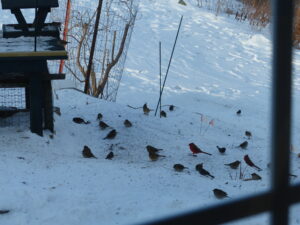
Birds flock to the seeds.
During warm months birds have no trouble finding tiny stones in bare patches of earth, but when the world is blanketed in snow or ice, they can’t find grit. Winter is when they appreciate swallowing a few tiny stones near bird feeders.
What Types of Grit Are Best?
As we fill our feeders at Winding Pathways, we sprinkle grit in with seeds and dribble some on the ground. We use two kinds of grit. When we have it on hand, we prefer baby chick grit that we buy at a farm store. It is tiny pieces of sharp quartzite that’s especially effective in grinding seeds in a gizzard. It’s sized for tiny baby chickens, so it’s just right for backyard feeder birds. When we don’t have it on hand we use regular sand. Traction and kid’s sandbox sand both work well and can be purchased at most home supply stores.
How Much Grit?
-

-
Birds flock to the seeds.
-
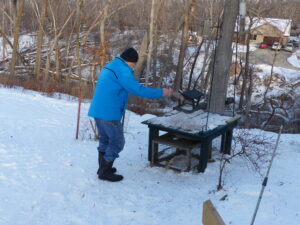
-
Sprinkle grit once a week to help birds in the snowy season.
-
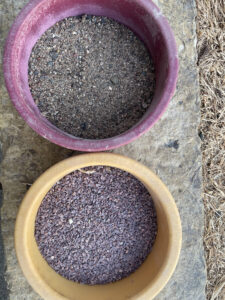
-
Spread grit when the ground is snow or ice covered.
Birds must have grit, but they don’t need much. A handful in and around feeders once or twice a week is plenty.
Other Uses
Grit’s useful around the house. When walkways are snow-slicked humans are mostly likely to slip and fall. Tossing grit on slippery walkways creates traction for people and may prevent a painful fall. Birds spot it there and occasionally pick up a few pieces. We keep about 50 pounds on hand and use most of it for traction and just a tiny fraction for our birds.
This winter when filling bird feeders scatter a bit of grit. Cardinals and other birds will appreciate it.
by Winding Pathways | Oct 24, 2024 | Bugs, Garden/Yard
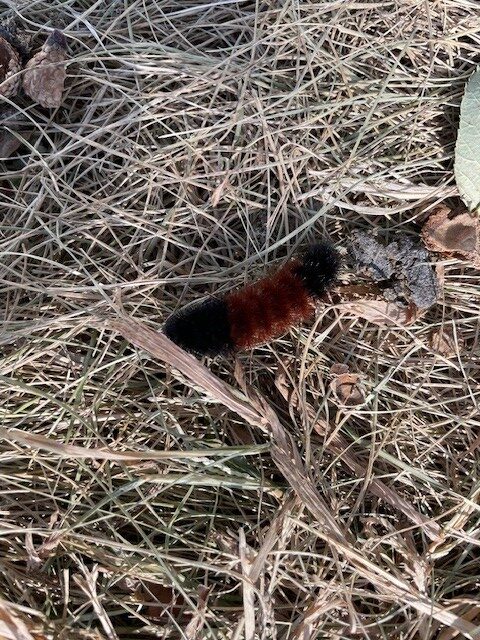
Wooly bears show up this time of year.
On a warm October afternoon bears were in our yard! Not to worry. They were wooly bears. Caterpillars. We like them and follow them as they scurry along as fast as their tiny legs can go.
Where are they going and how do they know how to get there? The answer to the first is simple. Wooly bears spend the late summer munching on plant debris, but when nights cool, they sense winter’s onset.
A wooly bear wandering around in October is looking for a snug place to overwinter. That could be in a rotting log or tucked under a porch. We often find them in January tucked in between chunks of firewood. When we discover one, we gently move it to another nearby safe spot so we can continue bringing in wood and it can continue slumbering until spring.
How Do Wooly Bears Know?
We can’t explain how they know where to find a place to overwinter. Maybe it’s a random search or somehow, they can sense safe places. It’s a fascinating mystery of nature.
What ARE Wooly Bears?
Wooly bears are cold-blooded, so their “wool “doesn’t help them stay warm. They have an amazing survival strategy. As the temperature drops to freezing a wooly bear’s heart stops beating. Then its gut freezes. Then its blood freezes, and soon the entire insect is frozen solid. Fortunately, frost crystals are outside its cells, so when warm weather arrives the wooly bear thaws and goes about its business.
How Many Species Are There?
There are eight species of wooly bear in North America. The adult phase is called an Isabella moth.
Predicting Weather
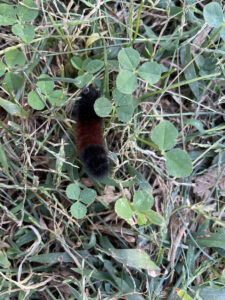
Winter Predictor?
Wooly bears are fun. We love watching them cross our driveway and twist their way through grass stems each fall. Can they predict the severity of the oncoming weather? Some people think so and carefully examine the bands of color on the caterpillar’s bristles that look like wool. We don’t take chances on wooly bear weather predictions and keep plenty of firewood on hand.
Woolly Bear Festival
Vermillion, Ohio, treasures its wooly bears. So do the 150,000 people who attend the Woolly Bear Festival, held annually in late September. It may be the Ohio festival attended by the most people.
by Winding Pathways | Sep 19, 2024 | (Sub)Urban Homesteading, 1080 Labyrinth Blog, Garden/Yard, Nature, Wonderment
Partnership with Sustainable Landscape Solutions Creates Natural Beauty
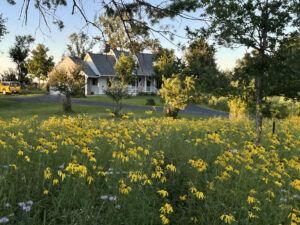
Brilliant flowers
When we bought our home near Cedar Rapids in 2010 we had a vision to transform the yard that had been sprayed and manicured by its former owner into a wondrous place, brimming with natural beauty and fascinating wildlife. It would be a delightful yard with prairie and savanna wildflowers bouncing in the breeze, and goldfinches and swallowtail butterflies winging over. We sought to create natural beauty.
We have years of ecological restoration experience. Rich had been restoring prairies and oak savannas since 1975 in his position as executive director of two nature centers. Like Rich, Marion is an inspired naturalist and a labyrinth expert. Together we had managed our former home for diversity, but the new property offered more space.
Beginning almost immediately, we planted prairies in portions of our front and back yards and worked with Linn County Roads to restore prairie in the nearby road ditch. This helped hold runoff water that could percolate into the ground.
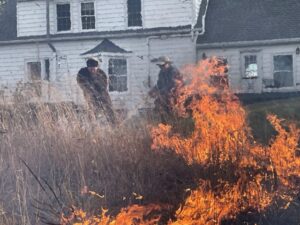
Working together.
Fortunately, we have experience managing fire. Rich is a former US Forest Service Hot Shot (wild firefighter) and we’ve used prescribed burns to help nurture the prairie. Burning has helped us resurrect native plants and wildlife.
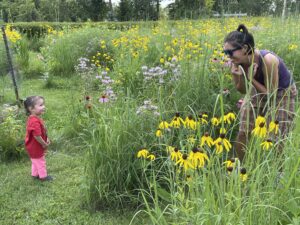
August – Joy is a part of labyrinths.
In their largest prairie Marion crafted the Phoenix Harmony Labyrinth. This is a five-circuit, dual-entry path to the center where people can enjoy a bur oak and be surrounded by prairie grasses and forbs. She welcomes people to play and encourages anyone wishing for moments of contemplation to visit and walk its curving paths between blooming prairie plants. Her labyrinth is listed on the international labyrinth locator registry.
How Sustainable Landscape Solutions
Helped the Pattersons
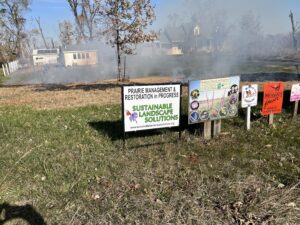
Several organizations and businesses are collaborating to create and manage the prairie.
We needed help with our newer projects. “We wanted to transform a hilly patch of our front lawn into a prairie rich in wildflowers and fewer tall prairie grasses. The site was a long-established conventional lawn composed of exotic grasses,” said Rich. “That’s a challenging environment to establish prairie. I’ve established prairies on lawns before by broadcasting seeds and following up with prescribed burns. But, it’s a slow process. We wanted to speed up restoration and needed help killing the turf and preparing the soil,” he added.
In 2020 we hired Sustainable Landscape Solutions to do the prep by first spraying the existing turf and later working the soil. Pattersons took it from there and planted a seed mix they purchased from Pheasants Forever. It’s called their Leopold Mix and contains seeds of 82 species of native prairie wildflowers.
Patience
It takes prairie time to mature. A year after planting we had a few blooms. The next year a few more. In its third year, it began to look like a prairie, and by its fifth growing season, the area was a magnificent spread of colorful flowers fluttering in the summer breeze. Alive with bumblebees, butterflies, and other insects, it was rich with life.
Next Steps
Four years later we decided to pursue a different sort of property upgrade. The 2020 Derecho did a job on a cozy nook next to the garage. “We wanted to transform a weedy nook south of our house into a delightful place to sit on cool spring and fall days where the sun would warm us. We worked with Virginia Hayes of Sustainable Landscape Solutions to come up with a patio plan that allows us and our visitors to sit and enjoy our thriving natural landscapes.
Patience, Again
Multiple rains delayed the project as Sustainable Landscapes worked diligently to catch up on already scheduled, and now rain-delayed projects. The new patio was crafted in July 2024. “It’s an example of how our company was able to work with homeowners to create a vision and gorgeous yard. Pattersons had much restoration knowledge but we’re happy to help people less experienced transform their yards into areas of natural beauty,” said Sean Pearl of Sustainable Landscapes.
-
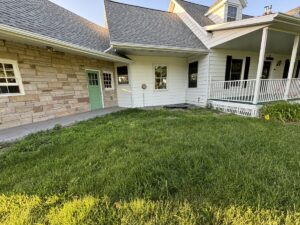
-
Weeds overtook the area
-
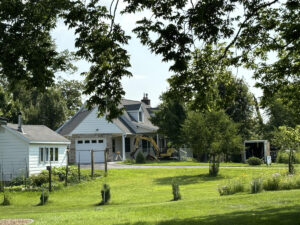
-
Small evergreens have replaced fallen Derecho trees.
-
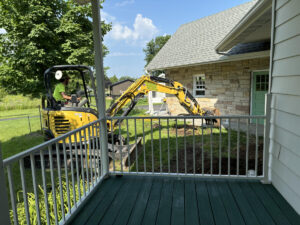
-
First removing dirt.
-
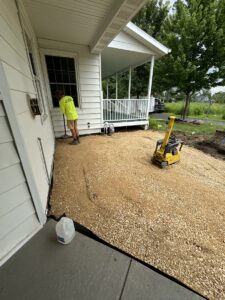
-
Next steps
-
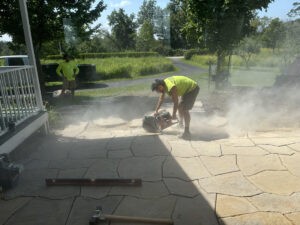
-
Dusty job
-
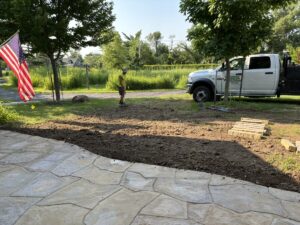
-
Water flows away

Coming together
Now, in early autumn, the nook is coming together nicely and we look forward to sharing it, the yard, and the labyrinth with others.
A Little More About Labyrinths
The Patterson’s labyrinth is created in a tallgrass prairie but these can be built in many ways, including in formal landscaping. “Many are made of bricks or pavers that enable a walker to negotiate the winding pathway,” said Marion. “Ours has a wide grassy path with borders of prairie grasses and forbs that change seasonally.” Labyrinths are structures with a path that winds to a center. Each time walkers follow the path around the center is called a circuit. Walkers find that the winding path slows down their minds and they can settle into a more relaxed space. Because of the natural setting, many walkers comment on how they recall times in nature as youth. Patterson is available to help landowners create labyrinths.
Blessings of the Changing Landscapes
We welcome visitors to our Winding Pathways website and to see our prairies.
by Winding Pathways | Aug 22, 2024 | Garden/Yard, Nature, Wonderment
Guest Blogger – Jacqueline Hull
Have you ever tried something fun as a gardener? Well, I have. My curiosity wondered if it were possible to root the head of a pineapple.
We love fresh pineapple. The head has to be cut off then the sides to get to the juicy pieces. Then, we stash the severed pieces in the compost pot for future use in the garden.
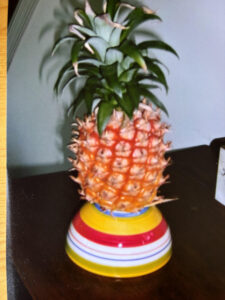
Will the pineapple take?
One day, after my husband, Peter, dissected our fresh pineapple, I retrieved the top piece and placed it into some moist potting soil. I made sure the soil was damp each day as I waited for it to root. After a time, to my delight, I discovered the head had indeed grown roots and was holding tightly to the soil.
For several years I fertilized and watered this pineapple as the spears grew larger and taller. I also transplanted it to a huge glazed pot.
Peeking down into the center of the plants one day, I saw a teeny tiny fruit that had developed. It kept growing and growing and eventually, a soft, golden color appeared in its greenery. It had about seven inches of fruit and I knew it was ready to be picked.
To our delight when we harvested the pineapple, the inside was sweet and juicy.
Now, we wait for the two that are growing on the porch to ripen. One has a fruit and we anticipate the other to develop its fruit.
Our adventure continues as we try to grow onions from pieces with roots and wonder if we could do the same with celery…maybe!
Editor’s note: Share your growing experiments with us on the comments page.
by Marion Patterson | Aug 1, 2024 | Garden/Yard, Mammals, Pests
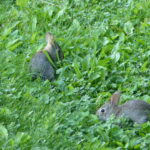
Young rabbits “play” to gain skills and show dominance.
Have you noticed the abundance of the cottontail rabbit this summer? While they can create mischief as in eating desired plants, they also are fun to watch.
Winding Pathway’s resident cottontail rabbits give us delightful evening entertainment. Shortly after sunset, a few appear like magic from out of our labyrinth’s tall prairie. As we sit on our porch they scamper about, chase each other, and nibble on the white clover poking out of our lawn.
Many people dislike cottontails for their habit of feasting on favored garden plants and gnawing on tree bark in the winter. Because we enjoy both rabbits and Swiss Chard, we keep them away from our vegetables and, thus, appreciate their antics.
Several cottontail species range across most of the United States, southern Canada, and South America. They’re well adapted to thrive in diverse environments. Ours is the Eastern Cottontail rabbit. This year they are especially abundant.
There are Rabbits and Then There are Rabbits
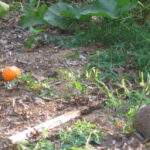
Side by side
Cottontails and common domestic pet rabbits may look similar but they are vastly different.
Pet Bunnies
Pet bunnies trace their ancestry to Europe and were domesticated thousands of years ago. They make fascinating and loveable pets and thrive in a safe roomy hutch eating commercial pellets. These are the rabbits that were released in Australia and caused enormous agricultural and ecological damage. They readily breed, are social, and join others to dig a series of burrows called warrens. Some readers may remember the award-winning novel, Watership Down, and the Netflix series about precocious rabbits.
-
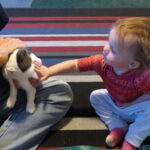
-
Children and adults enjoy bunnies.
-
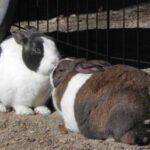
-
Rabbits are social.
-
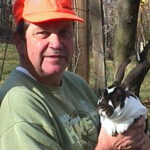
-
Friendly pets
-
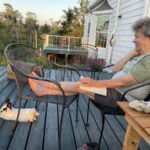
-
European rabbits adapt to people
-
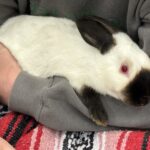
-
Show animals.
-
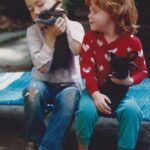
-
Children with rabbits
Cottontail Rabbits
Cottontails, in contrast, are wild animals that rarely, if ever, become tame or make good pets. Like European rabbits they are social and like the company of other bunnies but not people. Cottontails don’t make burrows but sometimes enjoy ducking down an abandoned woodchuck hole. Cottontails live under dense vegetation, in culverts, and under outbuildings. They eat a wide range of wild plants but love snacking on vegetables. In winter they sometimes eat the bark off young trees. So, be sure to protect your young trees with wire mesh around the base.
-
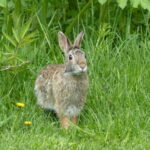
-
Time for an evening snack.
-
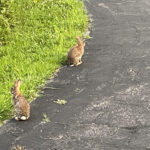
-
bunny play
-
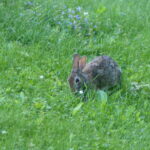
-
Nibbling clover
Enjoying Both Cottontails and Vegetables
Years ago, we learned a trick that lets us enjoy our resident cottontails and abundance from the garden. European rabbits are high jumpers, but not cottontails. Instead, native bunnies are long jumpers who can’t jump high. Just a wimpy two-foot-tall chicken wire fence around the garden or a young tree keeps them away as long as they can’t get under it.
-
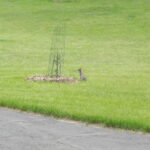
-
Keep rabbits away from young trees.
-
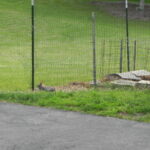
-
Cottontails cannot jump high.
Why So Many Cottontails This Year
For the past few years, Iowa has been in drought. It limited the new tender growth of clovers and other delectable plants that bunnies love. Sparse rain thinned thickets where they hide. This year’s been wet. Vegetation is tender and abundant yet we’ve not had big early thunderstorms. Why’s that important to a cottontail?
Before giving birth, a cottontail digs a shallow hole in the ground, often near the edge of a lawn. She lines it with fur and soon deposits three to eight tiny blind helpless babies. Mom mostly stays away but nurses them in the morning or evening by sitting over the burrow and letting her babies nurse. They grow amazingly fast and are out on their own when only about three weeks old. Mom soon gets ready for another litter.
Who Doesn’t Love a Cottontail Rabbit?
Predators love rabbits. They’re a favorite meal for dogs, cats, raptors, snakes, foxes, and coyotes. There are always rabbits because their survival strategy is to have many babies, even though only a small percent reach adulthood and reproduce.
Getting Rid of Cottontails
Well, why do it? They are inquisitive and beautiful animals that share yards with people.
An easy solution is to run chicken wire around desirable plants to keep them away. So, people can have their plants and rabbits, too.
Hooray for bunnies! They brighten our evenings as they scamper about our yard.
-
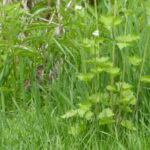
-
Rabbits know to stay hidden
-
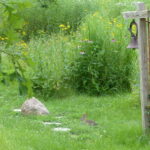
-
Cottontails live in the labyrinth.
-

-
Nibbling clover
by Winding Pathways | Jul 4, 2024 | (Sub)Urban Homesteading, Bugs, Garden/Yard, Garden/Yard, Nature
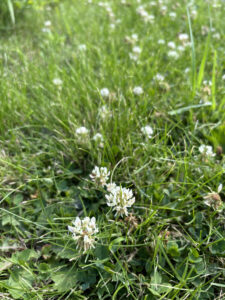
Mowers pass over low-growing clovers.
We recently discovered an amusing irony created by one of the most common lawn plants – white clover.
Sometimes called Dutch Clover, this low-growing plant graces unsprayed lawns in temperate regions across the globe. Normally, we discourage nonnative plants at Winding Pathways, but clover is an exception.
Although native to Eurasia, it’s not invasive. This important forage legume is likely the most widespread in the world. Diminutive clover is so low growing our mower passes right over its dainty flowers. Our friendly cottontail bunnies may seem to be eating grass, but actually, they’re feasting on clover. So are beneficial insects. As its flowers add beauty to the lawn and feed animals, clover’s roots pump nitrogen into the soil, helping other plants grow.
The irony
AI detected our Internet search for clover information. We began getting computer ads from landscaping companies encouraging us to hire them to kill our clover “and other weeds” in our lawn. No way!
Many people spend good money to poison beneficial lawn plants. They expose themselves, their pets, and anyone who walks on the lawn to toxic substances.
Maintaining a Healthy Bed of White Clover
White clover tends to gradually decline over the years. We’ve noticed this at Winding Pathways. To give it a boost we buy white clover seeds and sprinkle them on the lawn during cool months, especially on bare spots. Seed can be purchased online and in stores where hunters shop. These stores sell seeds beneficial to wildlife, and hunters often plant them to boost food for deer and wild turkeys.
-
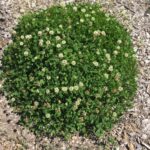
-
Clover can be manicured.
-
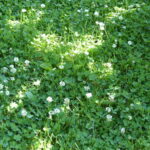
-
Sunlight on a clover lawn forms a cross.
-
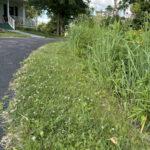
-
Dutch White Clover is low-growing.
Rewards
We have healthy lawns, rich with nitrogen. And, on summer mornings and evenings, we sit in our front porch’s rocking chairs watching bumble bees and bunnies foraging on our blooming white clovers. Thanks, clover.
-
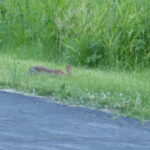
-
Bunnies enjoy clover.
-
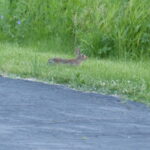
-
Watchful






































